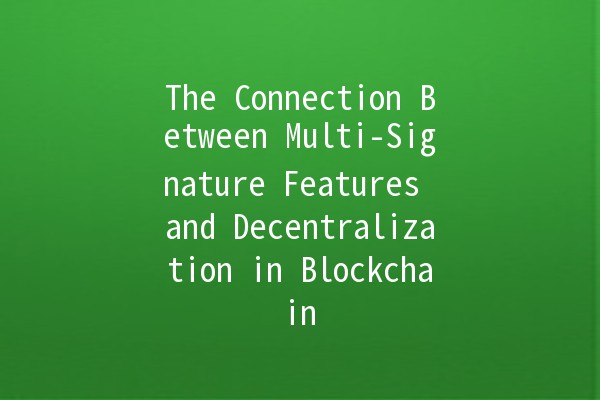




Multisignature (multisig) technology is a crucial innovation within the blockchain ecosystem that enhances security by requiring multiple signatures to authorize transactions. Instead of relying solely on one private key, multisig requires a combination of private keys from multiple parties, thereby distributing control and reducing the risk of fraud or loss. This functionality has profound implications for decentralization, a core principle of blockchain technology, as it democratizes access and control over digital assets.

At its heart, decentralization entails distributing authority and control away from a single, central entity. In the context of blockchain, it refers to the elimination of intermediaries and the promotion of an open network where users retain full control over their assets. By leveraging multisig features, users can further enhance decentralization, as these features require consensus among multiple stakeholders for any transaction to occur. This fosters a collaborative environment where trust is generated not through a single authority but through collective agreement.
One of the most significant benefits of multisig is its ability to provide enhanced security for digital assets. By requiring multiple signatures for fund transfers, the risk of unauthorized access is significantly reduced. For example, a company may set up a multisig wallet that requires signatures from the CEO, CFO, and a trusted thirdparty auditor to execute a transaction. This means that even if one private key is compromised, funds remain secure as multiple keys are needed to authorize any transfer. This security not only protects assets but also reinforces the decentralized ethos of empowering multiple stakeholders.
In traditional financial systems, the central authority’s failure can lead to significant losses. Multisig effectively reduces single points of failure by requiring consensus for transactions. For example, in a decentralized application (dApp), developers can implement multisig wallets where a minimum number of developers must approve any updates or changes. This way, even if one or two developers leave the project or become compromised, the dApp can still function and be updated, maintaining stability and operational continuity without central control.
Multisig features inherently promote accountability among stakeholders. Every transaction requires the approval of multiple participants, making it difficult for any single entity to act unilaterally. For instance, in a DAO (Decentralized Autonomous Organization), decisions regarding fund allocation can be made through multisig contracts requiring votes from various members. This ensures transparency and prevents misuse of funds, aligning with the core principles of both decentralization and collaboration.
Multisig wallets facilitate enhanced collaboration among team members, developers, and users. In a crowdfunding scenario, backers can utilize a multisig wallet where funds are held until predetermined milestones are met. This creates a collaborative environment where project creators are incentivized to reach their goals, knowing that funds will only be released when multiple parties agree on their progress. Such arrangements improve trust and engagement within the community, aligning individual incentives with collective outcomes.
As regulations surrounding cryptocurrencies and blockchain technology continue to evolve, multisig can provide a framework for compliance. Organizations can set up multisignature wallets that follow best practices in governance and asset management, enabling them to adhere to regulatory requirements while still enjoying the benefits of decentralization. For instance, a financial institution utilizing multisig can maintain transparency in financial dealings, allowing them to manage risks effectively while still decentralized.
The relationship between multisignature features and decentralization is integral to advancing the goals of security, collaboration, and transparency in blockchain ecosystems. By implementing multisig technology, users enhance their security posture, mitigate risks, and increase accountability amongst stakeholders. This ultimately contributes to a more decentralized environment, supporting the broader vision of blockchain technology as a tool for democratizing finance and fostering innovation.
A multisignature wallet is a type of cryptocurrency wallet that requires multiple private keys to authorize transactions. Unlike standard wallets that operate with a single key, multisig wallets distribute control and enhance security.
Multisignature enhances security by requiring multiple signatures to approve a transaction. This means if one key is compromised, the funds remain secure until the necessary number of keys authorize the transaction, reducing the risk of unauthorized access.
Decentralization is crucial in blockchain as it eliminates reliance on a central entity, promotes transparency, and empowers users. It ensures that no single point of failure can affect the entire system, enhancing trust among participants.
Multisignature should be used when managing significant sums of cryptocurrency, in business contracts, and in organizational fund management. For example, if a group of developers collaborates on a project, a multisig wallet can help manage funds collectively.
Multisig wallets require multiple parties to approve actions, fostering an environment of collaboration. This is particularly useful in crowdfunding schemes, DAO governance, and joint ventures, where shared decisionmaking is essential.
While multisignature wallets are more secure than singlekey wallets, they are not impervious to attacks. A multisig wallet can still be compromised if a significant number of private keys are obtained. Therefore, it remains vital to follow best practices for key management.
By providing a confluence of security, collaboration, accountability, and regulatory compliance, multisignature features redefine how we interact with digital assets, paving the way for a more decentralized future in blockchain technology.